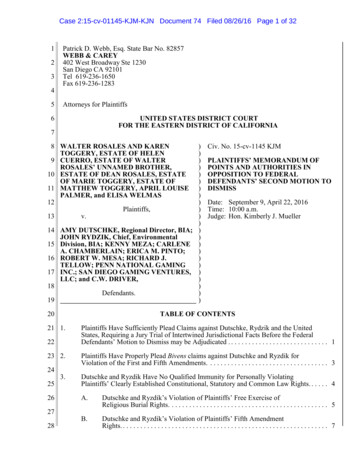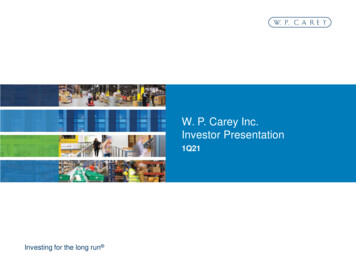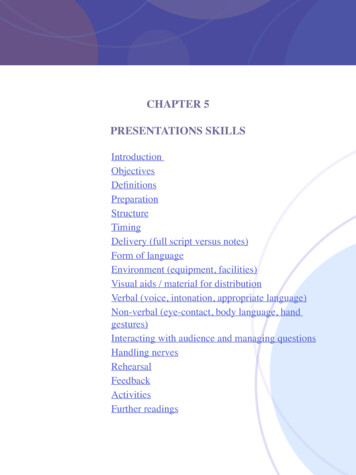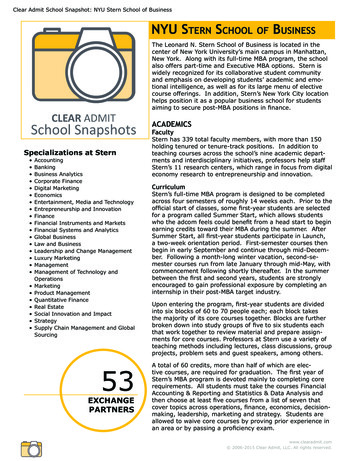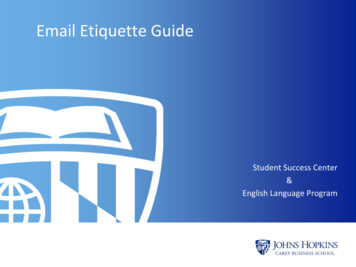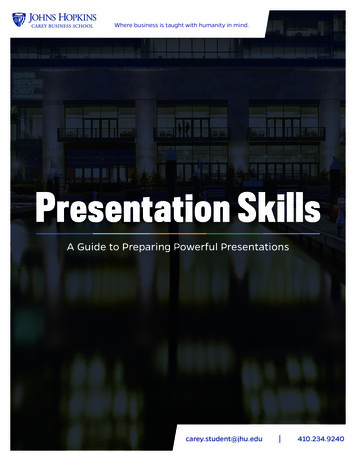
Transcription
Where business is taught with humanity in mind.Presentation SkillsA Guide to Preparing Powerful Presentationscarey.student@jhu.edu1410.234.9240
TABLE OF CONTENTSPresentation Skills Objectives3Presentation Checklist4Plan & PrepareKnow Your Audience5Know Your Objective/Purpose (Walk-Away Message)6Structure Models(Brainstorming & Building an Effective Introduction, Body and Conclusion)7PREP Model (How to Organize Content and Keep Your Topic Focused)8Use of Visual Aids & Word Choice9PracticeKeep Your Audience Engaged10Nonverbal Communication (Body Language Dos & Don’ts)11Tips for Practicing Your Presentation (And Tips to Improve)12PresentManaging Time and Environment13Anticipating and Handling Questions14Minimizing Nervousness15Appropriate Attire16Presentation Grading Rubric & Feedback17Student Success Center Services18References192
PRESENTATION SKILLS OBJECTIVES:Through engaging workbook activities and videos, this Presentation Skills session aims towalk students through the process of how to plan, prepare, practice, and present powerfulpresentations; students will utilize the information in this workbook every time they needto create a presentation.Self - Assessment1. What would you say is one of your strengths as a presenter?2. What skill(s) would you like to develop or improve? In other words, what is yourobjective for this Presentation Skills session?3
PRESENTATION SKILLS OBJECTIVES:To be viewed before, during, and after the presentation planning process. Have I planned an adequate amount of time to work on my presentation? (1hr/1min Rule)Do I have all of the important information about my audience?Do I have a clear objective/walk-away message?Do I reinforce my walk-away message throughout my presentation?Do I have an effective “hook” to grab the attention of my audience?Do I follow my “hook” with stating my objective and then clearly defining the main points thatI am going to be talking about in my presentation?Are the points of my presentation organized in a logical sequence?Do I have transitions between points that will help my presentation “flow”?Do my main points need support from visual aids?Do I have vivid examples to help illustrate each of my points?Does my conclusion summarize the presentation clearly and concisely?Have I tied my conclusion to my introduction and inspired the audience to take action?Am I knowledgeable and passionate about the topic covered in my presentation?Have I planned and practiced ways to engage the audience during my presentation?How will I present - what media will be used? Prezi? PowerPoint? Props? Poster? Nothing?Have I adhered to the 10:20:30 Rule? (Presentations should be no more than 10 slides,20 minutes, and the font size should be no smaller than 30 pt)Have I anticipated the questions I will be asked and have I considered how I will respond tothose questions?Do I have a back-up plan if my technology fails? A printout of my presentation?Where will I present? Have I visited the presentation site?Have I practiced my speech out loud, speaking slowly and clearly while projecting my voice?Have I paid close attention to my body language and posture while practicing?Have I timed myself or recorded myself?Are my visual aids easy to read and easy to understand?Are my visual aids properly linked to the points I am trying to communicate?Have I checked my visual aids to ensure they are working and that I know how to use them?Can images be easily seen from all areas of the room?Have I proofread all of the text on my slides and handouts to make sure that there areno mistakes?Have I made sure to be dressed and groomed appropriately for my presentation?Have I looked at the assessment criteria? Am I clear about expected content and duration?4
KNOW YOUR AUDIENCEThe first step in planning for a presentation is to know your audience.Ask yourself: Have I planned an adequate amount of time to work on my presentation? (1hr/1min Rule) Who is my audience? (Relevant demographic information: age, occupation, economic status,education level, cultural background, etc.) What does the audience already know about my talk? How many people will be in the audience? Where am I going to present to this audience? What does the audience want? What do they expect from this presentation? What is the purpose of presenting to this audience? How will the audience benefit fromthis presentation?“The quickest way to connect with an audience is to demonstrate that you understand theirbusiness, issues and concerns” (Koegel, 2007, pg. 128).How to learn more about your audience: Have I planned an adequate amount of time to work on my presentation? (1hr/1min Rule) Who is my audience? (Relevant demographic information: age, occupation, economic status,education level, cultural background, etc.) What does the audience already know about my talk? How many people will be in the audience? Where am I going to present to this audience? What does the audience want? What do they expect from this presentation? What is the purpose of presenting to this audience? How will the audience benefit fromthis presentation?Job Interview Tip:Utilize the above criteria to prepare for a job interview. Companies want to see that you haveresearched their institutions. In your interview, you should not only highlight your strengths asa candidate, but you must show how your strengths align with the mission and values of thecompany for which you are interviewing with.5
KNOW YOUR WALK-AWAY MESSAGEStart with the end in mind. After you have researched and studied your audience, you mustdetermine a clear objective or walk-away message that is catered to their needs.What is a “walk-away message?”Even the most attentive members of your audience will only remember a fraction of yourpresentation. Determine the most important messages that you want your audience to “walkaway” with and then reinforce those messages throughout your presentation.Ask yourself: What is my purpose? Is my goal to educate? Persuade? Motivate? Inform? What do I want the audience to feel, know, or do differently after my presentation? Can I state in one clear sentence what my presentation objective is?In your introduction you can say:“If you remember one thing as you leave here today.”Restate your walk-away message in your conclusion. Make sure that your “call to action” is clear.In your conclusion you can restate:“My purpose today was to help you understand how to.”Tell your audience exactly: What specific action they need to take How they should take that action When the action must be taken “Use this workbook as a guide for creating presentations.” “Follow the steps outlined in this workbook.” “Use this workbook for your presentation that you have to give at the end of the summer.”6
MODELS FOR STRUCTURING YOUR PRESENTATIONNow that you have established a clear objective for your audience, it is important to frameyour most important points and ideas in a structured way. Every presentation should havea beginning, middle, and an end. One method to start the outlining process is by recordingall of your thoughts on paper. Once you have done this, you can organize and prioritizeyour main points.Activity: Practice the following Brainstorming Methods:Freewriting:Mind Mapping:Writing Tip: Use these same methods of brainstorming and planning not just for presentations,but also for your writing assignments.7
WRITE A STRONG INTRODUCTION AND CONCLUSIONThere is much evidence to support that people tend to only remember the first and last thing thatthey hear. This is called the primacy and recency effect. Therefore, you should make the openingand closing of your presentation memorable.Crafting an Introduction:Ideally, an audience should not only listen to your presentation, but they should understand whatyou are saying and be influenced to take action. You only have a narrow window of time in yourintroduction to captivate your audience with a “hook.” A hook is the attention grabber with whichyou start your presentation. If you do not capture your audience’s attention from the beginning,then they will not listen to what you have to say, which means they won’t make an effort tounderstand you, nor will they act. You MUST grab your audience’s attention right from the start!Tell your audience exactly: Startling Fact or StatisticRelevant QuotationPose a QuestionTell a Story Give Examples Tell a Joke Use Realia or a PropWhat was the “hook” for thisPresentation Skills class?Don’t spend too much time on your “hook”; grab the audience’s attention, state your mainobjective, and then outline what you are going to discuss in your presentation:“My purpose today is. I am going to outline three ways you can utilizein order to make your business better.”Ask yourself:The purpose of a conclusion is to reinforce your main points and reiterate your main objective.You should tell your audience what specific action you would like them to take. If you do not havea strong conclusion, your presentation will be flat and your message will be lost. The following areways to end your presentation: Summarize your main points Tie it in with your Introduction/“hook” Look ahead to the future: Next Steps, Action Plan8
P. R. E. P. MODEL:A Formula to Keep You Focused on the Topic (Storey, 2014)Once you know your audience, and objective, and you have a map of your main points, you candevelop each point using the P.R.E.P. Model. This will allow you to keep your presentation simple,clean, and focused.Tip: main points should be arranged logically with clear and easy to follow transitions in between:“Now that we have discussed. I want to talk about.”POINT:(Make your point in ten words or less.)REASON:(Support your point by providing a clear reason why your audience should remember andunderstand your point.)EXAMPLE:(Give an example that will help illustrate your point and reason – examples from real life,story/parable, case study, analogy, statistic, etc.)POINT:(Restate your point. What is the main idea that you want your audience to remember?How will the audience benefit?)9
USE OF VISUAL AIDS & PROPER WORD CHOICEMost people retain information better when it is presented visually in addition to audibly.Incorporating visual aids can enhance your presentation especially if they support and clarifyyour message.Visual aids not only illustrate your points, but they can serve as visual cues for you to rememberwhat you want to say.Be careful not to inundate your audience with distracting images or complex charts and graphs.Remember: Use visual aids sparinglyOnly use high-resolution images and graphicsMake sure that visuals can be seen from the last row of your audienceAvoid miscellaneous visuals that make your slides look “busy”Present one key point per visual (i.e. avoid having too many lists and bullet points)Avoid slides with light text on a dark backgroundUse light colored backgrounds – use color carefullyDo away with decorative images on your slides; they can be distracting – ask yourself, “Doesthis need to be included?”Test equipment and have a back-up planDo not walk in front of the projectorKeep your face to the audienceBring a hard copy of your presentationMake sure you have an electronic copy of your presentation as a backup (email it to yourself)Utilize handouts if there is a lot of information that can’t fit on a slideWord ChoiceAs business school students, you will come to realize, if you haven’t already, the importance ofeach word that you use when communicating. You must put thought into how you choose words.In order to convey your message clearly you should keep language simple. Be clear, be appropriate, and be vividAvoid using jargon that could confuse your audienceAvoid absolutes such as ‘never’ and ‘always’- these words invite people to prove you wrongCome to the Writing Center for help with appropriate word choice10
KEEP YOUR AUDIENCE ENGAGEDOnce you have a well-structured and well-designed presentation, you must practice bringingyour message to life. You should practice delivering your presentation with passion andconviction. In addition, you should think of ways to engage your audience during yourpresentation. If you don’t attempt to engage your audience, then your message will be lost.“I hear and I forget. I see and I remember. I do and I understand.” - Chinese ProverbWays to engage your audience: Phrase your points and examples in the form of a question so that the audience can participatein your presentation. Ask questions and wait for a response. Examples:“Raise your hand if?”“How many of you have ever?”“True or false?” Ask the audience for their opinion. Encourage audience participation through partner or group activities.Tip: Audience members who expect to participate pay closer attention than those who don’texpect to participate. Ask someone to read a quote or an example aloud. Have the audience actively fill in an outline. Use vivid stories, examples, or video clips that match your message and help to illustrateyour points. Reward audience members for a correct response (recognition or a piece of candy).Tip: Never read from your slides.Reading from your slides tells your audience that you are not prepared nor are youknowledgeable on the topic of which you are presenting. Also, your audience can read fasterthan you can speak so you will likely have lost them.11
NONVERBAL COMMUNICATIONResearch has shown that the way people retain information is less from the actual words andmore from the context in which the information is presented. People learn 7% from what theyhear, 38% the way words are said, and 55% from what they see. Therefore, our voice and ourbody language must be congruent with our words.Activity: Analyze Nonverbal cues in the “Friends” video:https://www.youtube.com/watch?v OvEci5Bjgd4Body Language Dos and Don’ts:Do: Connect with your audience Smile (genuine, not phony)Appear natural and relaxedKeep your arms and hands at your side; use appropriate hand gesturesBe aware of your posture; stand with your shoulders backStand tall and on the balls of your feet, make a VMake eye contact for 3-4 seconds with people from all parts of the roomMove with purpose, energy and enthusiasmPause, which allows you to breathe and remain calmDon’t: Rock, sway, shuffle or leanSlouchClasp your hands behind your backLook downPut your hands in your pocketsDo the “T-Rex” stanceFidgetGrab or touch inanimate objects like chairsRead from your notesTurn your back to the audienceHomework Assignment:Go out in public. Study the body language of others in addition to being aware of your own.Stand tall with your shoulders back. Make eye contact with different people for at least threeseconds each. Offer them a smile. Do you feel more confident?12
PRACTICE TIPS AND WAYS TO IMPROVE Know your introduction and conclusion coldRehearse your presentation at least three timesPractice to remember ideas, not wordsPractice out loud, preferably in front of someone who can give you constructive feedbackPractice from your notecardsPractice in “chunks,” or divide up your presentation so that it is easier to remember the mainpoints of each section Record yourself Listen to the recording of yourself while you are doing mundane tasks Practice your presentation using your visual aids Time yourselfSpeak naturally and in a conversational toneUtilize vocal varietyEliminate “Ums”, “Uhs” and other “filler” language from your vocabulary (e.g. “Basically,Actually, Really, To be honest, In my opinion, I think, etc.”). Watch TED Talks to study not only how presenters gesture and move, but also how they havestructured their presentations.Activity: Watch this TED Talk: http://www.ted.com/talks/ric elias“The three things I learned while my plane crashed” Analyze the structure of the presentation Analyze the nonverbal communication and delivery Discuss with classHomework Assignment:Go to: www.ted.comSearch: Amy CuddySelect Amy Cuddy: Your body language shapes who you are“Amy Cuddy’s research on body language reveals that we can change other people’sperceptions – and even our own body chemistry – simply by changing body positions.”Practice your 2 minute “Power Pose” every day and do it before you present!13
MANAGING TIME AND ENVIRONMENTExample structure of a 20 minute PresentationOpening:2 minutesMiddle:13 minutesClosing:2 minutesQuestions:5 minutesTips to effectively manage time and environment: Always arrive early to your presentation (at least 30-45 minutes in advance)Ensure that the room is set up correctly – do you need to move tables and/or chairs?Test microphone and all other equipment to ensure that it worksBring a bottle of waterMake sure that you have a clock in your view so that you can keep track of timeAfter you have taken care of the logistics above, you should be available to meet and greetaudience membersStart conversations – remember information from these conversations so that you canrefer backStart on time; respect your audience’s timeIf, due to unforeseen circumstances, you are informed that you have less time than you wereoriginally given, you should leave out information instead of “rushing through”End on time – never go over your allotted time; your audience will focus on the fact that youare taking up their time and then your message will be lost14
NONVERBAL COMMUNICATIONAlways leave time (at least 5 minutes) at the end of your presentation for questions, assessmentand/or feedback.Preparing for a presentation doesn’t just mean organizing your message; it often requires youto gain a deeper understanding of the topic on which you are presenting. Simply put, you shouldknow significantly more about your topic than your audience. If you are thoroughly prepared,then you will be able to address most questions.Tips for answering questions: Don’t try to answer a question that you don’t know the answer to; Try saying:“I am not sure about , but I will look into it and contact you.” Answer in a conversational tone Answer concisely Keep your composure and be tactful in your response (don’t get defensive if someone asksa difficult question) Break down difficult questions in to parts and answer each one at a time Repeat and rephrase the question: Try not to compliment one question over anotherUse the Q-BEST-Q Formula:QRepeat the questionBState the bottom line (short and sweet)EGive evidence to supportSSummarize and restate your bottom lineTBe aware of timeQAsk: Have I answered your question?15
MINIMIZING NERVOUSNESSNervous? You’re not alone! 75% of people identify themselves as having some sort of speechanxiety. The key is to harness that nervous energy and use it to propel you forward in deliveringyour message with passion and enthusiasm. Use nervous energy to create positive results!Ask yourself, “Which mental approach will I take?”Option A: “Oh my gosh, every eye in the place is staring at me. I have to stand here for thirtyminutes and speak to this group.”Option B: “I have critical information that can make a positive difference for the people in thisroom. I have thirty minutes to help them understand this information. Let’s get started.”Focus on your message and the audience instead of focusing on yourself. It’s not about you. It’sabout the message to your audience.More techniques to minimize nervousness: Memorize the first two minutes: not word for word, but know it “cold” so that you feelcomfortable; starting off on the right foot can set the tone for the rest of your presentation. Utilize cheat sheets in the form of handouts: Write one word on a handout, which will serve as acue to help you remember your point. Rehearse, rehearse, rehearse! Rehearse out loud in front of a mirror or a friend;don’t forget to practice projecting your voice as well as moving naturally around the room(see nonverbal communication p.12). Break up your presentation into 3 Minute Segments. Take deep breaths. Be aware of your body position. Don’t drink caffeine, carbonated water, juices or cold water. They can make you anxious,gassy, or they can constrict your throat. Avoid large meals. Greet people as they arrive; mingling beforehand helps you relax. Visualize Success: picture yourself delivering an awesome presentation!16
APPROPRIATE APPEARANCE/ATTIREYou can never get a second chance at a first impression. Research shows that people judgeyou within the first few seconds of seeing you. It is critical that you not only carry yourself in aprofessional manner, but you must also dress appropriately for all occasions.Your attire is the first thing your audience will see when they walk into your presentation. Theywill be more open to your message if you carry yourself with confidence and if you’re dressed inappropriate yet comfortable clothing.Try your outfit on ahead of time to be sure it fits well and allows you to move comfortably.For Men: Make sure facial hair is trimmed and neat Your tie should be conservative, without odd prints orcartoon characters, and its color should not attract attention Be prepared and bring a backup tie or coat in casesomething goes wrong Presenting without your blazer can make you seemfriendlier to your audienceFor Women: Understated makeup Low heels (or flats if heels are uncomfortable) No cleavage or short skirts (skirts should be at orbelow knee level) Keep your hair out of your eyes and away from your face Avoid shiny jewelry that could distract your audience Avoid tight clothing as it draws attention to your bodyinstead of your message A cardigan or blazer looks professional, but presentingwithout it can make you seem friendlier to you audience17
INDIVIDUAL PRESENTATION EVALUATION FORMThe Speaker:AgreeDisagree1. Clearly identified & addressed an intended audience123452. Gave an effective introduction that caught my attention123453. Made the thesis of the talk clear in the introduction123454. Identified and addressed a specific problem123455. Articulated an argument built on sound evidence123456. Established information sources and their credibility123457. Effectively addressed counterarguments and obstacles123458. Organized the talk well (unity, coherence, transitions)123459. Provided effective concluding remarks1234510. Made good use of time1234511. Made good use of A/V1234512. Engaged the audience effectively1234513. Pronounced words clearly and was easy to follow1234514. Used effective volume and pacing1234515. Used effective non-verbal communication12345Comments:18
STUDENT SUCCESS CENTER SERVICESThis workbook is intended to not only walk you through the process of preparing a presentation,but it also should serve as a guide for creating future presentations. If you follow the steps in thisworkbook, you can prepare an effective and well-structured presentation. However, in order toimprove as a presenter, you must continue to practice!Go back to page #3. Did we address your objectives in today’s session?The Student Success Center offers tutoring not only for Writing, but also for Presentation Skills.We can help with everything from brainstorming and structuring to providing feedback on yourdelivery and nonverbal communication.Book an Appointment any time by going to the Student Success Center website:http://carey.jhu.edu/sscContact Information:Please email carey.tutoring@jhu.edu for all questions about Student Success Center tutoring andworkshops, or please contact your Instructional Coach directly:Harbor East – Marisa Alger (410) 234-9345; marisa.alger@jhu.eduWashington D.C. – Kristina Tipps (202) 650-6032; Kristina.tipps@jhu.eduThe Student Success Center will offer Advanced Presentation Skills workshops in the fall whereyou will have the opportunity to practice delivering a presentation as well as build upon thefundamental presentation skills outlined in this workbook.If you are interested in attending a fall workshop on Advanced Presentation Skills, pleaseprovide your email below, tear off, and give to your instructor.19
REFERENCESKoegel, T. J. (2007)The exceptional presenter (First Ed.). Austin, TX: Greenleaf Book Group Press.Storey, K. K. (2014)12 Principles for powerful presentation skills. Baltimore, MD: Interactive Training.20
PRESENTATION OUTLINE SHEETPresentation to (Audience):Date:Time:What is the most important message you want your audience to remember?My Purpose (Mission/Objective/Goal/Walk-Away Message) is:Point #1: (PREP)Point #2 (PREP)Point #3 (PREP)Restatement of Purpose:21
PRESENTATION OUTLINE SHEETPresentation to (Audience):Date:Time:What is the most important message you want your audience to remember?My Purpose (Mission/Objective/Goal/Walk-Away Message) is:Point #1: (PREP)Point #2 (PREP)Point #3 (PREP)Restatement of Purpose:22
PRESENTATION SKILLS OBJECTIVES: Self-Assessment Through engaging workbook activities and videos, this Presentation Skills session aims to walk students through the process of how to plan, prepare, practice, and present powerful presentations; students will utilize the information in this w
